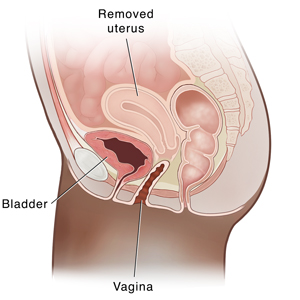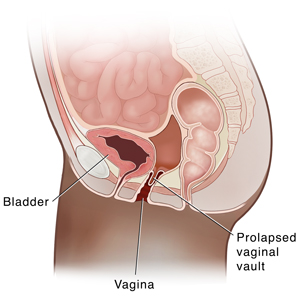Pelvic Organ Prolapse: Surgery for Vaginal Vault Prolapse
Vaginal vault prolapse is when the vagina loses its support and drops toward the opening. Sometimes it drops beyond the opening. This can happen after the uterus has been removed. Surgery is done to fix the problem and ease your symptoms.
 |
| Normal post-hysterectomy anatomy. |
 |
| Vaginal vault prolapse. |
The surgical procedure
A vaginal vault suspension may be done. This type of surgery can be done through the vagina or the belly (abdomen). The vagina is attached to strong tissue in the pelvis or to the sacrum. This is a bone at the base of the spine that forms the back of the pelvis.
Possible risks and complications of surgery
Your incisions
During surgery, the surgeon reaches your pelvic organs through the vagina or the belly. A cut (incision) may be made in the vaginal wall. If surgery through the belly is done, the surgeon makes a few small cuts to insert tiny laparoscopic tools. Or the surgeon makes one larger cut. This larger cut can be up and down (vertical) or across (transverse).
© 2000-2024 The StayWell Company, LLC. All rights reserved. This information is not intended as a substitute for professional medical care. Always follow your healthcare professional's instructions.